HIV Anal Sores Singapore | Shim Clinic
| Help me about HIV Anal Sores ! |

| Permalink: https://shimclinic.sg/hiv-anal-sores |
Sores on the anus can be very uncomfortable. They can be caused by many STDs, including HIV, syphilis, and herpes. In the early phase of HIV infection, there may be other HIV symptoms as well, including fever, nausea, and rash. Only a few people who have an early HIV infection develop sores.
Sores on the anus can be very uncomfortable. They may cause itching, burning, or pain. There may be bleeding associated with the sores. Having a bowel movement is very uncomfortable when you have anal sores, so many people with this symptom may also develop constipation because they try to hold their bowel movements. There are many bacteria in the area, and an anal sore may get infected by these bacteria, which is called a “secondary infection.”
Anal sores can be a feature of the early phase of HIV infection, which is known as acute HIV infection. Many people also have sores on other parts of the body, including the mouth, esophagus (the tube that carries food from the mouth to the stomach), and genitals. These are usually small open sores or ulcers, and they are usually painful. Only a small proportion of those with acute HIV develop the sores, so their absence cannot be assumed to mean that you don’t have HIV. Other potential symptoms of acute HIV infection include fever, nausea, and rash.
- Sores on the anus can be very uncomfortable, and can lead to complications like constipation or a secondary infection.
- Anal sores can be a feature of the early phase of HIV infection. There may also be sores on the genitals, in the mouth, or in the esophagus.
- Other STDs, including syphilis and herpes, can also cause anal sores.
- If you have anal sores, then you’ll need STD testing, including an HIV test.
Other sexually transmitted diseases (STDs) can also cause similar sores. One very common example is herpes, which is caused by the herpes simplex virus (HSV). Those infected with HSV remain infected for life. There is usually a burning sensation associated with herpes sores, and it may begin before the sores themselves actually appear. They will go away, but may return many times throughout life. Syphilis can also cause an open sore or ulcer to appear on the anus or genitals, although it is usually painless. In addition to STDs, there are other potential causes of anal sores. Having other HIV symptoms along with your anal sores makes it more likely to be HIV, but you can’t know for sure without an HIV test.
If you have anal sores, then you’ll need STD testing, including an HIV test. Your blood will be tested for antibodies (an immune response) to HIV, syphilis, and herpes. In addition, your blood will be tested for HIV antigens, which are proteins that the virus makes. In some cases, your doctor may collect fluid from your sores and test this as well.
It takes some time for the body to generate antibodies in response to an infection, so these won’t always be detected early in the infection. If the test is negative but no other cause for the sores is found, you will most likely be asked to return for another HIV test in case the first one missed your HIV infection.
Sources:
Mayo Clinic. “STD symptoms: Common STDs and their symptoms.” Mayo Clinic. Published 18 Mar 2015. Accessed 20 Jul 2016. http://www.mayoclinic.org/std-symptoms/art-20047081
Centers for Disease Control and Prevention. “Screening Recommendations Referenced in Treatment Guidelines and Original Recommendation Sources.” Centers for Disease Control and Prevention. Published 04 Jun 2015. Accessed 20 Jul 2016. http://www.cdc.gov/std/tg2015/screening-recommendations.htm
Centers for Disease Control and Prevention. “HIV/AIDS.” Centers for Disease Control and Prevention. Published 05 Jul 2016. Accessed 27 Jul 2016. http://www.cdc.gov/hiv/
Centers for Disease Control and Prevention. “HIV Basics – Testing.” Centers for Disease Control and Prevention. Published 12 Jul 2016. Accessed 20 Jul 2016. http://www.cdc.gov/hiv/basics/testing.html
U.S. Department of Health & Human Services. “Post-Exposure Prophylaxis (PEP).” AIDS.gov. Published 21 Sep 2015. Accessed 20 Jul 2016. https://www.aids.gov/hiv-aids-basics/prevention/reduce-your-risk/post-exposure-prophylaxis/
| Timeline | HIV | STD | Pregnancy |
|---|---|---|---|
| Before exposure | |||
| Contraception (females only) | |||
| HIV PrEP (pre-exposure prophylaxis) - Stop HIV infection before exposure | STD vaccine: - Hepatitis vaccine - HPV vaccine | ||
| STD / HIV exposure | |||
| 0-72 hours | HIV PEP (post-exposure prophylaxis) - Stop HIV infection after exposure | STD testing * - Screening test - to look for asymptomatic infections - from previous exposures | Emergency contraception with the morning-after pill (females only) |
| 2 weeks | HIV DNA Test | ||
| 1 month | HIV 4th Generation Test - SD Bioline HIV Ag/Ab Combo - Fingerprick blood sampling. - 20 minutes to results | ||
| 3 months | HIV 3rd Generation Test - OraQuick® HIV-1/2 Antibody - Oral fluid or - Fingerprick blood sampling. - 20 minutes to results | STD testing * - Full & comprehensive - diagnostic test - to look for current infections | |
| Watch for | HIV Symptoms | STD Symptoms | |
| If infected | HIV Treatment | STD Treatment | Abortion |
References
